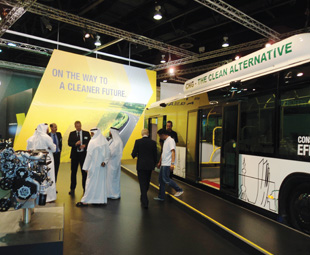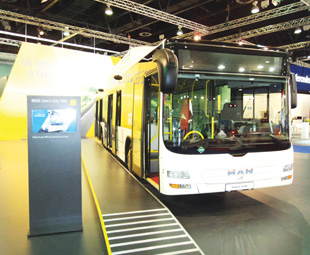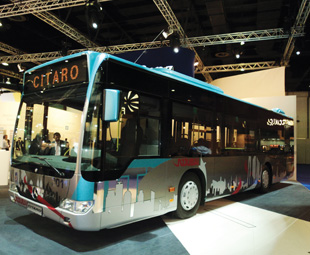Arresting event

The who’s who of public transport recently gathered in Dubai for the 59th World Congress and Exhibition of the International Association of Public Transport (UITP). CHARLEEN CLARKE joined them… and managed to get herself arrested in the process.
Things work well in Dubai. Even law enforcement is pretty good. I can proudly attest to this, having been arrested. My utterly horrendous crime? Sitting in the wrong compartment on the metro. Dubai has some pretty crazy rules – there are different classes on the metro (gold, which is kind of posh) and regular (as posh as the Gautrain… so just dandy). The metro is like London’s underground – which is why it’s a bit crazy. (Not sure about other FOCUS readers, but this was a first for me – I’m accustomed to different classes on planes or longer train journeys only.)
There are also compartments on the train that are exclusively used by women and children. If you sit in the wrong compartment, there is a pretty good chance that you will be arrested (as happened to yours truly and two other equally ignorant tourists). Thankfully, I cannot attest to the conditions in jails in Dubai. Once you get arrested, you are fined by a polite official who (sorry for you, my fellow South Africans) cannot be bribed. Not that I tried to do so. I am, of course, a law-abiding honest citizen (who just happens to get arrested occasionally). But I say this because the official was incredibly apologetic when he realised I was an ignorant tourist, explaining that he would love to let me off the hook – but could not do so because “everything is recorded on camera”.
I have no clue if he was telling the truth or not. But probably yes, because, as I said at the outset, things work well in Dubai. Not just law enforcement, but public transport too. And also events…
Firstly the public transport. I was overwhelmed by the range of cost-effective (assuming you’re not being fined) and convenient public transport options. From cheap taxis to spotlessly clean, efficient buses, air-conditioned bus shelters and metros… you really can manage sans a car in Dubai. This is the result of a deliberate policy on the part of local government. As Hans Rat, UITP secretary general noted: “The Emirate is a fantastic example of the dramatic and positive change that is possible with a ‘can-do’ attitude, and is all the more impressive because it happened in a region with abundant oil resources thought of until recently as a cheap-petrol paradise for cars. But Dubai chose not to blindly follow a path leading inevitably to car-choked streets.” As such, Dubai is vigorously pursuing its vision of being a city where an integrated public transport system forms the bedrock of clean, smoothly running, innovative (and air-conditioned) services appreciated by its inhabitants. This policy makes sense – and cents. According to Mattar Al Tayer, chairman of the board and executive director of the Roads and Transport Authority (RTA), public transport cuts the financial burden of traffic congestion. “This is estimated at AED4,6 billion (R9,13 billion) per annum,” he tells FOCUS.
 UITP delegates could choose from a host of public transport options (it was possible to reach the congress and exhibition from all the major hotels using public transport only). One option, of course, was the dreaded metro, which is a driverless system covering 75 km and serving 47 stations. Then there are the trams, which run over 15 km, and the buses. The bus fleet, by the way, has grown from 560 in 2005 to more than 1 500 in 2010 (all new buses meet Euro 4 standards). Over the same period, the number of bus riders has increased from 85 to 120 million. If delegates wanted to cross the waterways, there were water taxis or water buses at our beck and call.
UITP delegates could choose from a host of public transport options (it was possible to reach the congress and exhibition from all the major hotels using public transport only). One option, of course, was the dreaded metro, which is a driverless system covering 75 km and serving 47 stations. Then there are the trams, which run over 15 km, and the buses. The bus fleet, by the way, has grown from 560 in 2005 to more than 1 500 in 2010 (all new buses meet Euro 4 standards). Over the same period, the number of bus riders has increased from 85 to 120 million. If delegates wanted to cross the waterways, there were water taxis or water buses at our beck and call.
The actual event was equally impressive. Local congress and exhibition organisers could take a leaf out of the UITP’s book. From logistical arrangements to the quality of the congress speakers… this was one of the most interesting and well organised industry events I’ve attended in years.
Okay, so now that I have sung the praises of both Dubai’s public transport and the actual event (I paid my own way, just in case you’re wondering; so this is totally unbiased reporting), what did I see and learn?
Well, firstly some fascinating facts and figures pertaining to public transport. For instance, according to the UITP, 13 million people are now employed in the public transport sector worldwide (this excludes interurban and long-distance transport, informal transport and taxis). The Eurasia region has the highest density of employment in public transport – 6,8 jobs for each 1 000 urban residents – while Sub-Saharan Africa has the lowest at 0,25 jobs for each 1 000 urban residents.
Operators are the biggest employers, accounting for 7,3 million people employed fulltime; authorities employ 300 000 people and there are five million people employed within the supply chain, who provide goods and services to the operators and authorities.
Of course, if the UITP achieves its stated goal of doubling public transport’s market share by 2025, this will mean that these numbers will double. “Public transport is a ticket to prosperity street,” Sylviane Delmas, chairperson of the UITP Commission on Business and Human Resources Management RATP France, noted during the congress.
“The public transport operators are already the largest employers in cities such as Amsterdam, Barcelona, Brussels, Genoa and Dublin. Public transport operators fall within the top five employers in cities like Paris, Budapest, Porto, Madrid, Turin and Tallinn. And, in the USA, investment in public transport produces twice as many jobs per dollar as investing in roads,” she noted.
But, for public transport to function effectively, operators need the right products and services… enter the exhibition component to the event. It was very well supported and so I cannot possibly do justice to each and every exhibitor. As such, here is a very brief overview of some of the stands.
ALLISON TRANSMISSION
Allison showcased new 2011 transmission upgrades and highlighted the breadth of its product range by exhibiting four transmission families at the UITP. Visitors were also able to learn about Allison’s latest transmission technology features and optimization packages created for public transport applications – such as Vehicle Acceleration Control (VAC), which has proven reduced fuel consumption by up to 7% in actual operation, and Prognostics, which can further reduce maintenance costs.
Among new transmission upgrades available with 2011 model year products is the enhanced torque converter lockup feature now extended to the Allison 1000 and 2000 Series transmissions. Designed to enable the transmission to shift very early into lockup in first range, the feature will improve fuel economy for specific missions such as school buses. The Allison Torqmatic range now features Variable Modulated Main (VMM), which modulates the pressure required in the internal lubrication system to further increase transmission efficiency and improve fuel economy.
The company displayed a cutaway model for school buses, smaller buses, and coaches of up to 13 000 kg GVM; a T280R transmission – designed for buses up to 24 000 kg GVW; and the T525R, which is the largest Allison product in this range. The T525R transmission is suitable for the largest coaches on the market with engines up to 410 kW and up to 2 305 Nm.
“It is timely that this year’s UITP is being held in the Middle East, where imports of buses equipped with Allison transmissions are growing,” said Manlio Alvaro, Allison’s Europe, Middle East, and Africa marketing manager. “New BRTs in these markets require transmissions for every bus size, and Allison is unique in that it can supply fully automatic transmissions for mini-buses through to large coaches.”
IRISBUS IVECO
Irisbus Iveco promoted its vast range of midi, standard and articulated buses (Citelis models) and its BRT/high level service buses (Crealis models), announcing at the UITP significant test results relating to the former and sales successes with the latter.
Since its market launch in March 2005, more than 7 000 Citelis buses have been produced as complete vehicles, chassis for the major European bodybuilders and PKDs (semi-finished vehicles) for trolleybus applications in various countries in Central and Eastern Europe. The Citelis is especially successful in the compressed natural gas (CNG) sector – almost 4 000 of these buses have been sold in Europe to date.
Irisbus Iveco is now also producing a hybrid Citelis in 12 and 18 m guise, and initial fuel consumption tests are extremely encouraging. At the UITP, the company announced it had achieved a reduction in fuel consumption of 39% on a flat city line at an average speed of 11,5 km/h, while the gain amounted to 33% on a hilly city service at an average speed of
12,8 km/h. The drop was 24% on a city-intercity service at an average speed of 24 km/h.
Yet another Irisbus Iveco, the Crealis, holds considerable promise, having been developed with accessibility for all passengers. It has an all-flat floor and is equipped with sliding doors enabling both a better flow of passengers entering and exiting the vehicle and increased accessibility for passengers with reduced mobility, with prams and for wheelchair users. To date, five French networks (including RATP in Paris) have chosen Irisbus Iveco for their BRT, totalling 83 Crealis and Crealis Neo, both in 12 and 18 m lengths.
INIT
Integration is the key topic in public transport. This movement is backed by the trend of enhanced co-operation in public transportation networks, as well as the ongoing need to make public transport more efficient and attractive. As such, INIT presented solutions allowing public transportation companies to build an overall multi-client solution fully integrating all processes of ticketing, fleet management (Intermodal Transport Control System – ITCS) and real-time passenger information.
Never heard of the company? Neither had I. But it is a big player within the public transport game. Together with four Bavarian bus companies of the Deutsche Bahn, as well as many other bus operators, INIT has been responsible for the largest integrated and fully multi-client capable ticketing, ITCS and real-time passenger information project in Germany. With the successful installation of more than 3 000 busses in Bavaria, INIT has successfully proven capability of this integrated approach – even for larger fleets. The company really knows its oats – for instance, INIT offers the unique advantage of fully incorporating the processes of ticketing with operations control and real-time passenger information.
MAN
MAN Truck & Bus took advantage of the UITP Congress in Dubai to unveil a new version of its Lion’s City CNG designed  especially for very hot countries. The vehicle on show, a 12-metre low-floor solo bus, is driven by a turbocharged six-cylinder engine powered by natural gas. The engine delivers 228 kW while its emissions are way below the limits set for EEV, currently the most stringent emission standard.
especially for very hot countries. The vehicle on show, a 12-metre low-floor solo bus, is driven by a turbocharged six-cylinder engine powered by natural gas. The engine delivers 228 kW while its emissions are way below the limits set for EEV, currently the most stringent emission standard.
I discovered at the UITP that MAN is the market leader in gas-powered city buses. Major markets for gas-powered buses and engines are The Netherlands, Turkey, Germany, Sweden, Australia, Austria, Portugal, Iran and Spain. MAN’s share of the European market for these buses has averaged 44 percent over the past eight years. In fact, from 2007 to 2009, MAN’s share was over half the market.
The company has been producing these vehicles for a quarter of a century: as far back as 1972, MAN buses with gas-powered engines were shuttling Olympic athletes and spectators to the stadiums in Munich and its environs. Some 20 years later, the MAN SL 202 with CNG-powered engine celebrated its premiere and in 2003, MAN delivered the first EEV-compliant gas-powered buses to its customers. In the meantime, MAN has delivered more than 5 000 gas-powered buses and bus chassis with gas-powered engines.
Turn to page 72 and you can read more about the company’s extremely interesting UITP stand.
MERCEDES-BENZ
From big to small… the Mercedes-Benz display at the 59th UITP Congress proved that public transport solutions can come in a range of sizes. First the big, which took the form of the Citaro – the undisputed number one, the worldwide best-seller among the urban regular service and inter-urban buses. More than 30 000 Citaros have been built since series production was launched in 1998.
A total of 28 different design variants are available, ranging from the compact
Citaro K measuring 10,5 m in length through the four-axle, 19,54 m CapaCity articulated large-capacity bus to alternative drive concepts featuring EEV, gas, hybrid and FuelCELL hybrid variants (see more on page 78).
The Citaro has even won an entry in the Guinness Book of Records as the largest ambulance in the world: in 2009, official jurors confirmed that a large-capacity rescue vehicle based on the Citaro offered the necessary capacity to treat and transport 123 casualties.
Now the small. Mercedes-Benz also used the UITP to promote its innovative car2go concept. Thanks to car2go, if you’re in the German cities of Ulm and Hamburg or the Texan capital of Austin and you need a car, it can be hired spontaneously on the road or booked using a mobile phone, smartphone or on the internet from home. The vehicle can then be used for as long as it is required and subsequently returned to any available public car park within the car2go operating zone. The customer is billed per minute.
VDL
VDL promoted the Citea SLF-120h, a serial hybrid that will be available in overseas markets from the fourth quarter of this year. The vehicle incorporates a systems integrator with overall responsibility for the generator, supercaps, power electronics and energy management, from Vossloh Kiepe, a four-cylinder Cummins diesel engine and a ZF electrically-driven rear axle that includes two hub motors (integrated into the axle).
This hybrid will be available in three versions: Basic Hybrid, Basic Zero Emissions Hybrid and Advanced Zero Emission Hybrid. With the Advanced model, it’s possible to drive a pre-established part of a route entirely on electric power (with obvious zero emissions resulting).
VOLVO
We all know that we need to resolve the traffic and environmental problems in cities by persuading more people to leave their cars at home and use public transport instead. But how? This means that attractive, comfortable and rapid transport systems must be provided. Enter the BRT. “A system that is based on buses is highly flexible,” notes Peter Danielsson, who is the BRT manager at Volvo Buses. “It is able to transport as many passengers as a rail-bound system, but at only a fraction of the cost.”
Volvo Buses is currently the leading global manufacturer of buses for BRT systems. In South America, which has the largest portion of BRT systems in the world, Volvo Buses has a market share of more than 70% in terms of buses for the systems.
“We have been involved since the first system was introduced in Curitiba in the 1980s and have extensive experience of the demands placed on the transport system and the buses that are used there. Consequently, we have a broad range of buses for various applications within BRT,” Danielsson pointed out.
To encourage people to leave their vehicles at home and travel by bus instead often requires that the journey time is shorter by bus or at least will not take longer. Consequently, the BRT systems are based on providing the highest possible transport efficiency.
“In cities that have introduced well-developed BRT systems, the improvements to the city environment are highly evident,” said Danielsson. “The portion of inhabitants that choose to use public transport has increased significantly, the air quality in those cities is much better and the traffic has become safer.”
However, there is more to be done to increase the attraction of buses and reduce travel time further, both in BRT systems and normal city bus traffic. Volvo Buses is highly involved in this work, particularly through the major research programme entitled European Bus System of the Future (EBSF).
EBSF is a programme that is supported by the European Union. Its goal is to make bus travel in cities more attractive by developing new buses, new solutions in the infrastructure and collating the good examples that already exist.
Some 47 partners are participating in the research programme, including the largest bus manufacturers in Europe, and the total budget is €26 million.
The results of this project are bound to be fascinating. Watch this space – we will report on future EBSF in subsequent issues of FOCUS.
Published by
Focus on Transport
focusmagsa




 FUSO: Driving the Future of Mobile Healthc
FUSO: Driving the Future of Mobile Healthc



 New Electric Van Range Unveiled!
New Electric Van Range Unveiled!  A brand
A brand




 Wondering about the maximum legal load for a
Wondering about the maximum legal load for a 
 The MAN hTGX powered by a hydrogen combus
The MAN hTGX powered by a hydrogen combus


 Exciting News for South African Operators
Exciting News for South African Operators






